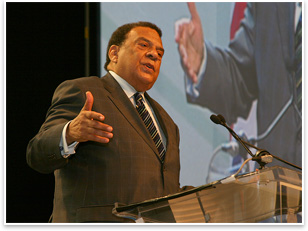
Andrew Young Calls on the Humanitarian Face of Private Development
“The crowning achievement of Whitney’s ministry, as I call it, was that he engaged the private sector,” said the former Atlanta mayor, ambassador to the United Nations, and civil rights activist. “Whitney Young learned that you could do more in a board room than you could on a street corner or a government office.” Since his days marching and protesting with Martin Luther King Jr., Young said he’s seen the need for new social activism change and grow. New and widening social fissure are based on economic class and the “haves and the have-nots,” he said. Though King is typically defined in racial terms, Young pointed out that he was perhaps more aware of class inequality as it functioned beyond and through race, as evidenced by his multi-racial “Poor Peoples” coalition. “American cannot survive with people isolated on lonely islands of poverty in the midst of an ocean of material wealth,” he said. “And it seems to be getting worse. [This] may be the worst time I have known for poor people in my 76 years.”
“I’m basically a preacher,” he said. “My job is to find a way to feed the hungry, clothe the naked, and heal the sick, and I don’t know how to do that except through private enterprise, except to inspire architects to conceive of new ideas that will generate jobs. You all are at the heart of this poverty program.” One of his first priorities as mayor was to steer government contracts to more and more minority and female-owned businesses. Though Atlanta was 70 percent African-American, less than 1 percent of such contracts ever left the hands of white men. “We began to see that unless we included everyone in the growth and development in the city of Atlanta, it would not grow very long, and it would not grow very well,” said Young. “We didn’t have any complaints because what we were doing was creating new wealth. We developed a private sector that understood that there is a fortune at the bottom of the pyramid, and that if you build the economy from the bottom up, everybody will get pushed up.”
The mission “Now is one of those times that tries men’s souls, and women’s too,” Young said to conclude his speech. “I want you to see the world as it should be, and don’t ask why not—figure out how to finance the change, figure out how to design the improvement.” |
||
Copyright 2008 The American Institute of Architects. All rights reserved. Home Page |
||
news headlines
we the people
business
members connecting
Recent Related
› Keynoter David Suzuki Issues “The Nature Challenge”
› Green is the Word: AIA Kicks Off National Convention
› Gore to AIA: Architects Needed More than Ever
Photos by Aaron Johnson
Innov8iv Design
idistudio.com

 Summary:
Summary: Development for all
Development for all Lessening government bureaucracy and red tape to grease the wheels of commerce was one of Young’s strategies to do this. “Anyone who wanted to develop in Atlanta or invest in Atlanta could walk into my office without an appointment,” he said. “It took me five minutes to take a picture with them, see what they were interested in, and if it looked like it made sense, I assigned them to one person who would walk them through [the process]. It used to take seven months to get a building permit. We cut it down to seven minutes,” he said, to hearty applause.
Lessening government bureaucracy and red tape to grease the wheels of commerce was one of Young’s strategies to do this. “Anyone who wanted to develop in Atlanta or invest in Atlanta could walk into my office without an appointment,” he said. “It took me five minutes to take a picture with them, see what they were interested in, and if it looked like it made sense, I assigned them to one person who would walk them through [the process]. It used to take seven months to get a building permit. We cut it down to seven minutes,” he said, to hearty applause.